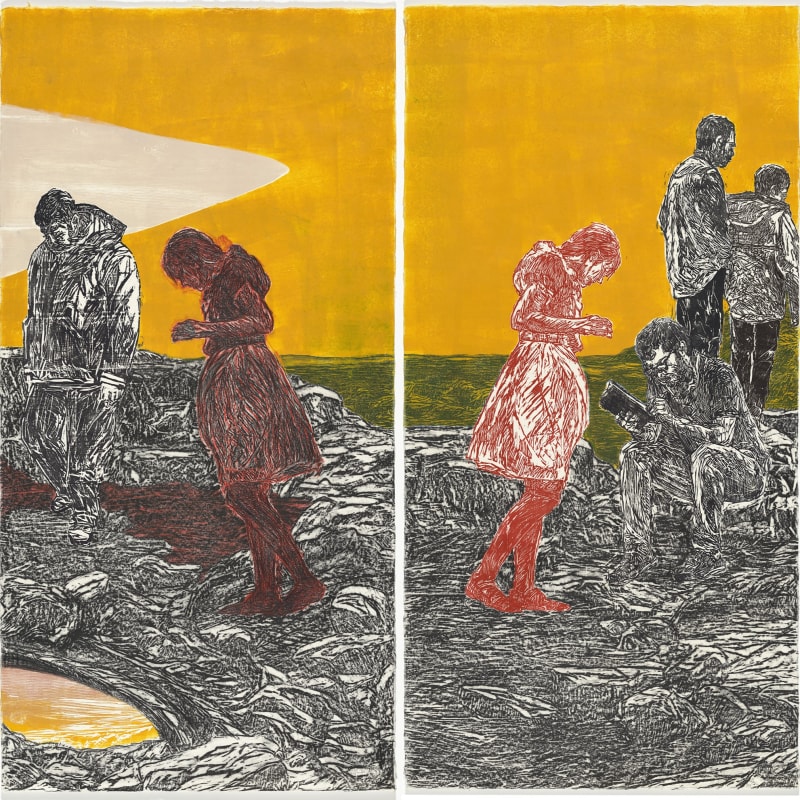The passionate, informed collectors Ruth Cole Kainen and her husband, the abstract painter, curator and scholar Jacob Kainen, were among the most munificent patrons of the National Gallery of Art. Between 1974 and 2012, together and separately, they donated more than 2,000 European and American paintings, drawings, watercolors, prints and illustrated books from the 16th to the 20th centuries. These lavish gifts included works by artists ranging from Northern Mannerists to the couple's friends Stuart Davis, Arshile Gorky, Willem de Kooning and Mark Rothko, with an emphasis on prints-etchings, engravings, woodcuts and lithographs.
Over the years, the Washington museum has mounted exhibitions celebrating this extraordinary gift-currently "The Anxious Eye: German Expressionism and Its Legacy," organized by Shelley R. Langdale, the National Gallery's curator and head of modern and contemporary prints and drawings. Ms. Langdale reminds us of the discomfiting parallels between the present day and the first half of the 20th century in Europe, similarly marked by political upheavals, war, social unrest and economic inequities. "The Anxious Eye" examines how artists working in Germany and Austria responded, mainly in printmaking, as the settled order of the 19th century was replaced by the speed, bright lights and instability of modern life. The selection honors the depth and excellence of the Kainens' gifts, as well as other important sources of the National Gallery's rich holdings, showcasing works recently acquired or rarely on view.
"The Anxious Eye" is both illuminating and full of surprises. Sections headed "Portraiture," "Nature and Spirituality," "Relationships and Body Language" and "Sources of Inspiration" offer exemplary works by everyone we expect to see: Max Beckmann, George Grosz, Erich Heckel, Ernst Ludwig Kirchner, Käthe Kollwitz, Emil Nolde, Lovis Corinth and their notable colleagues. But there are also unfamiliar images by these well-known artists and memorable ones by such little-known figures as Walter Gramatté, a member of the Expressionist group Die Brücke, who died of tuberculosis at age 32, in 1929. Gramatté's drypoint with watercolor "The Great Anxiety (Self-Portrait in Three-Quarter Profile to the Right)" (1918) is the show's emblem. He confronts us with an emaciated green face, reduced to enormous staring eyes and pointed chin, and a gnarled bony hand.
For the artists in "The Anxious Eye," printmaking offered both a connection to a long, distinguished tradition-think Albrecht Dürer and Martin Schongauer-and opportunities for experimentation. Kirchner's ferocious portrait of his psychiatrist, "Dr. Ludwig Binswanger" (1917/1918), all slashing lines and violent cross-hatching, challenges the meticulousness of the traditional woodcut, making the evidence of the brute labor of cutting and excavating into a metaphor for intense feeling. Super-heated emotion, made visible as wrenched forms, angular bodies and freewheeling, experimental techniques, is a constant throughout. Even seemingly calm, ordered images, such as Kollwitz's or Beckmann's introspective self-portraits, exploit tonal shifts for drama and expression. In contrast to the prevailing Sturm und Drang, a work such as Kirchner's woodcut "Women Bathing Between White Stones" (1912), with its smooth patches of color and suavely outlined nudes, one in a fetching hat, seems positively cheerful and benign.
That may be because for most Germans and Austrians, in the years examined by "The Anxious Eye" and for decades after, being "one with nature"-even on chilly, pebbly beaches-was seen as healing and enriching. (I speak from uncomfortable summer visits to German friends.) Spending time among forests, fields and bodies of water was an escape from the tensions of urban life, a symbolic return to a simpler, Edenic state, the equivalent of the Arcadia of the south. Otto Mueller's skinny nudes in a landscape may not evoke the nymphs and shepherds of their Mediterranean counterparts, yet as deliberately uningratiating representations of the unclothed body, they signal freedom and the rejection of bourgeois values. Mueller and Corinth cast other nudes as Adam and Eve, updating Dürer's celebrated print, but unlike Dürer's, featuring unidealized, irregular bodies. The proximity of prints with religious themes to relatively straightforward landscapes by Nolde and Heckel emphasizes the spiritual virtues assigned to the natural world.
The influence of the formal elements of non-Western art, acknowledged as the result of European colonization of Africa and Oceania, is accounted for. The continued relevance of the innovations and emotional charge of the works on view is attested to by "German Expressionism Reimagined," dedicated to prints by modern and contemporary artists with an appetite for intensity and transgression. Not surprisingly, a rough-hewed print by Georg Baselitz reprises the mood of his Expressionist compatriots' efforts. More unexpected are Nicole Eisenman's etching of a beer garden and woodcuts by Kerry James Marshall and the Israeli artist Orit Hofshi. Mr. Marshall offers a tense male figure, while Ms. Hofshi confronts us with an enormous multi-panel work dealing with migration and displacement. And more. Is that continuity because all art tends to be, on some level, a response to other art? Or does it reflect the same disquiet that provoked the work in "The Anxious Eye"?

